"RM10" vs "25%" off
Which discounting strategy will be more attractive? RM10 or RM25% off? Here's what the rule of 100 says.

Your boss just gave you the green light to run a discount sale. Nice. Laziest marketing at its finest. You type canva.com in your URL, choose a template, put a price slash, and then...
Wait. Should I write it as a RM10 discount? Or 25% off?
Which one is going to be more attractive?
The rule of 100.
Coined by Jonah Berger in Contagious, the idea is that a RM40 shirt will be more attractive at 25% off versus RM10 off.
But a higher priced RM5,000 laptop will be more attractive with RM500 off, than 10% off.
Whoa.
Life (and price) is merely a perception.
Perception is reality.
The reason why RM500 off a RM5,000 laptop feels like a better deal is because of the psychological effects of perception.
Put simply.
We feel RM500 off an expensive laptop is a better deal, because we value RM500 (which is a lot of money) compared to a percentage like 10%.
However, when the item is small, like a RM40 shirt – we feel a 25% discount is more than RM10.
People are lazy.
Math is hard stuff. Humans are wired to do the least possible.
Most won't bother calculating the percent discount on an item. When they see an item at 45% off – they perceive that as a lot.
With high-priced items though – it's unlikely that you'll be discounting that highly, so using a value-based discount may be more effective.
To recap the rule of 100:
- Over RM100? Put price discounts. (E.g. RM500 off!)
- Below RM100? Put percentage discounts. (E.g. 25%!)
Other psychological pricing strategies.
Here are another 3 of our favorite psychological pricing strategies that might be useful for you:
1. Reduce the left pricing.
Which feels cheaper? RM29.90 or RM30?

The reason you said RM29.90, even if you knew this is a pricing tactic... is that we typically process words & numbers from left to right.
When the number on the left is smaller (2 is smaller than 3), we perceive it to be cheaper. Although it's just really 10 cents.
2. Break down to a daily cost.
This psychological pricing works really well if you're selling something expensive.
Let's say you sell bed mattresses at RM2,000 each. And a typical customer uses a mattress for at least 10 years. So if we break it down to daily cost – that would be just about RM0.54 per day. (Less than a cup of coffee!)

This creates an anchoring effect.
Your customer will compare this daily cost to the price of a coffee. Suddenly, your mattress seems like an affordable deal.
3. Add bonuses.
This pen costs RM90, but if you get it, we'll include 3 additional pens... for free!
Much better than selling 4 pens for RM90.

This works because, in your mind, the pen costs RM90. The price is anchored. But then you get another 3 pens, for free! What a great bargain.
Lazy marketing.
At the beginning of this post, I mentioned 'laziest marketing'.
That's because discounting is the laziest form of marketing.
Any fool can sell a product by offering it for a discount, it takes great marketing to sell the same product for a premium. - Rory Sutherland, vice chairman at Ogilvy & Mather.
Overly discounting will cut your business profits and position you as a commodity.
Also, if you discount your main product, you're basically telling people that your prices are negotiable.
Instead of discounting, add bonuses that will bring more value to your customer's experience.
